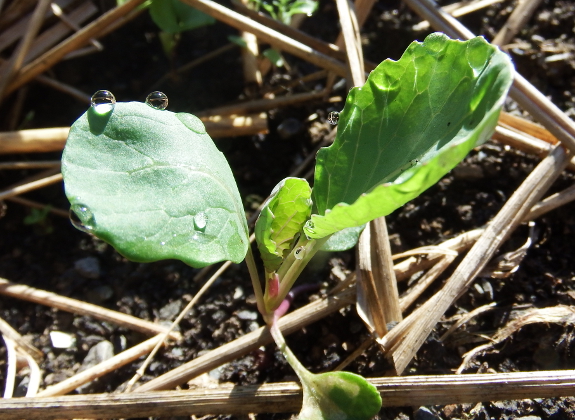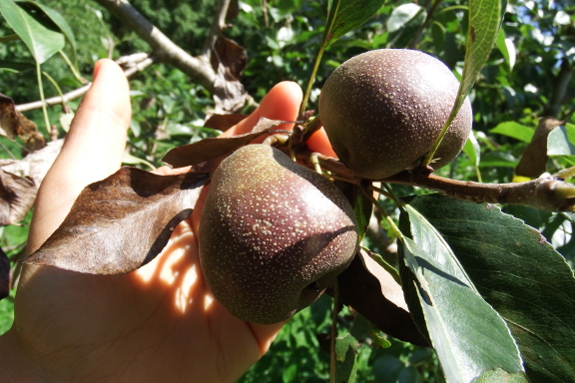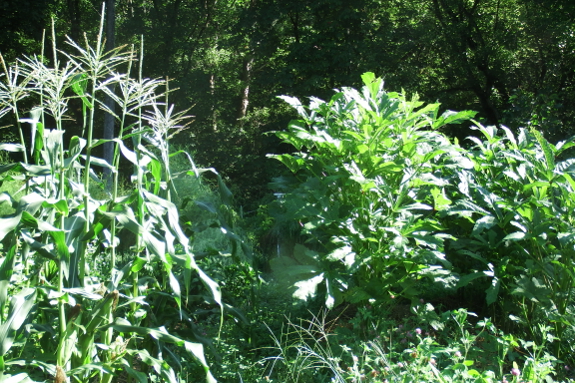
Stocking up on winter-research topics

In the middle of the
summer, I'm so engrossed in the garden that I just don't have the mental
energy to research deeply into the solutions to thorny problems. Then,
in the winter, all I can remember is the beauty and deliciousness of our
past successes. So I thought now might be a good time to note some
problematic areas of our current garden for future research.
As basic as it sounds,
I'm still a seed-starting amateur. When I start seeds inside under
low-light conditions (I'm too cheap to use a grow light), they often
succumb to damping off. I put the flats outside in the summer sun and
they dry up in a heartbeat. Next, I try to start those same seeds in a
shady damp bed outside, in which case they get eaten up by (I assume)
slugs. And by the time I finally give up and just start the seeds in my
happy garden soil under heavy irrigation, it's often too late for fall
crucifers to have time to grow before our first hard freeze. As you can
see, our brussels sprouts are a bit smaller than I'd hope for at this
time of year, and our fall broccoli may be nonexistent. Definitely a
topic to research! First stop will be The New Seed-Starter's Handbook.

With our tree fruits, I
feel like we're 80% of the way to success...but close only counts in
horse shoes and hand grenades. One obvious issue is the fire blight
on our Seckel pear, but that's probably not worth researching. I
already know that I should have cut out the problematic limbs when they
first started appearing, and I also know that Seckel isn't as disease resistant as other pears we're now trying. Hopefully variety selection will nip this problem in future years.
Late spring freezes are a
more pressing issue since this seems to be the biggest hurdle
preventing us from getting tree fruits at the moment. This winter, I
want to research freeze protection (it really might be worth wrapping
some of our dwarf trees and hardy kiwis) and to start setting out
thermometers at potential orchard areas to gather data on anti-frost
pockets. It's painful to have mature, beautiful trees that simply don't
bear because of one late spring frost, so this topic is near the top of
my research priority list.

It's not a research
topic, but this year I've been more aware than ever before of how
differently my vegetables perform in full sun (tiny patches of our homestead)
versus partial sun. Our okra, for example, is providing about ten times
as many fruits as in previous years. Why? Because I finally put this
non-essential crop in the center of the sun zone. As our garden soil
gets better and better and we're able to shrink our growing area, I want
to be sure to focus our mulch- and fodder-producing crops in the
partial-sun areas to save the full-sun for vegetables.
What's on your winter research list so your 2016 garden will blow this year's effort out of the water?
Want more in-depth information? Browse through our books.
Or explore more posts by date or by subject.
About us: Anna Hess and Mark Hamilton spent over a decade living self-sufficiently in the mountains of Virginia before moving north to start over from scratch in the foothills of Ohio. They've experimented with permaculture, no-till gardening, trailersteading, home-based microbusinesses and much more, writing about their adventures in both blogs and books.
Want to be notified when new comments are posted on this page? Click on the RSS button after you add a comment to subscribe to the comment feed, or simply check the box beside "email replies to me" while writing your comment.

My very best garden year included a drip system for watering, and starting seeds indoors. We don't get rain from April until October usually. No matter how much I want to hand water, making use of warm-up-the-shower water or veggie-washwater, my plants tell me my efforts aren't the same as drip irrigation. I intend to buy/get a rain barrel so I can still conserve, while giving the plants more of what they want. Our water company also offers free non-potable water that's ok for edible plants, but doesn't strain the drinking water reservoirs. Our spring/summer warms slowly. So tomatoes, peppers, and melons take until July or August to ripen. Starting seeds made that best garden sing in late June.
Good post! I am so caught up in preserving our harvest and trying to transition garden beds to get ready for fall planting..but I already have a list of 'research' subjects in my farm notebook for winter! I'm also a seed starting newbie..... its hard!!! I managed to start all my own seeds (well over 200 plants) this year.. only had to buy banana peppers.. because I forgot to buy seed!! Love The new seed-starters handbook! Our fruit trees are so sad... I don't know if they'll ever amount to anything..our most productive fruits are asian melons, blackberries, ground cherries ,and muscadines. I discovered a huge elberberry bush this year..wow! they are great! Our neighbors who hate their pears and let us gather them...and a local orchard that sells seconds $10 a bushel! Pretty much does it for our fruits here!
I've come up with a pretty successful and inexpensive setup that seems to have eliminated most of my seed starting issues.
I got a couple of four foot fluorescent "shop" lights and put one warm and one cool bulb in each (which gives full spectrum light but is way a way cheaper setup than "grow" lights), and hang them on lightweight chains from the ceiling. This lets me adjust the height so I can keep the light just a few inches above the tops of my seeds, which helps prevent them from getting leggy. This setup cost less than $40 total.
Next, I set up my oscillating fan to blow across the seed trays. This helps keep the soil at the top of the trays dry (thus decreasing damping off issues), mostly eliminates those annoying gnats that seem to love hanging out in the dirt around indoor plants, and the breeze encourages the seedlings to grow sturdier stems.
Lastly I always water my seedlings by pouring water into the tray my seed flats rest in, then after 20 minutes to an hour (whenever I get back to it) I dump the excess water. The soil will absorb as much water as it needs but won't get water-logged and can drain any extra, which is a huge help in preventing damping off.
This year I also got a heat mat, which did increase my germination rate a fair amount, but I'm not 100% sold on whether it was worth the cost. If it lasts more than 5 years I think it will be worth it, but I'm holding off on buying another for now.
Good post. It got me thinking. I faced a couple of major hurdles this year, (which, admittedly, is our first year here so I oughta be happy that anything went well at all). The first thing I will be researching will be better winter squash varieties that are perhaps less susceptible to vine borers (curse them and all their ancestors) but still provide good storage squash. The second will be better timing of succession planting of early spring crops. Despite my best efforts, all the leaf lettuce staged a coup and matured at the same time. Gallons of it a day!
And the third will be planning a greenhouse. We are collecting old windows, and its going to be a hodgepodge of all these free reclaimed windows... should be interesting!
Such great comments on this post, everybody!
Deb --- You might try butternut squash. They're our favorite for flavor, storage, and disease/pest resistance. Good luck with your new greenhouse!